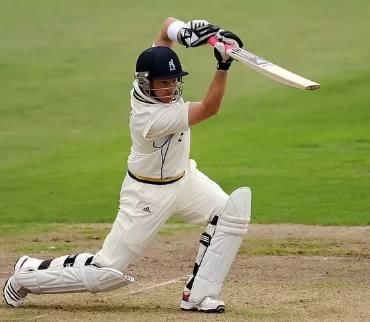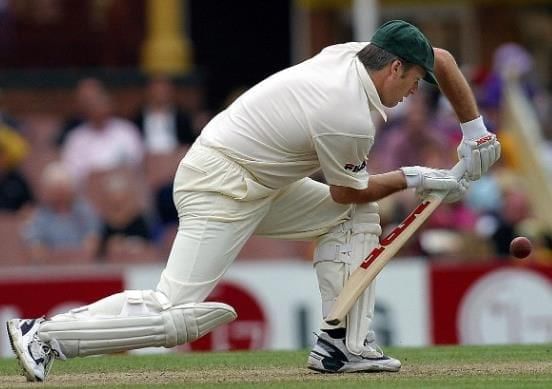Year 6 Exam > Year 6 Notes > Physical Education for Year 6 > Essential Skills and Techniques: Cricket
Essential Skills and Techniques: Cricket | Physical Education for Year 6 PDF Download
| Table of contents |

|
| The Cricket Straight Drive |

|
| The Cricket Forward Defensive Shot |

|
| The Cricket Overarm Bowl Technique |

|
| The Cricket Overarm Throw Technique |

|
| The Cricket Long Barrier Technique |

|
The Cricket Straight Drive
A straight drive is a purposeful shot designed to strike the ball along the ground to avoid being caught.

Stage One
- Position your feet shoulder-width apart, aligned with the batting crease.
- Slightly bend your knees, keeping your weight evenly balanced.
- Place your top hand and the bat’s handle lightly against the inner thigh of your front leg, with the bat resting on the ground at a 45° angle.
- Position your head above your front foot, facing the bowler.
Stage Two
- As the bowler nears, keep the bat close to your body and lift it by bending both elbows until it’s level with your shoulders.
- When the ball is released, step your front foot back behind your front knee and chest, keeping your back leg straight with the foot firmly planted.
- Your head should align with your front knee, and your back foot should rise onto its toes.
- Upon contact, swing the bat downward in a straight line, keeping elbows bent and fixed, until the bat’s face points upward.
The Cricket Forward Defensive Shot
A forward defensive shot is a calculated stroke aimed at protecting the wicket or the player’s pads from the ball.

Stage One
- Stand with feet shoulder-width apart, parallel to the batting crease, knees slightly bent, and weight evenly distributed.
- Rest your top hand lightly against the inner thigh of your front leg, with the bat angled at 45° and touching the ground.
- The head is over the line of the front foot and facing the bowler.
Stage Two
- As the bowler approaches, keep the bat near your body and raise it by bending both elbows until it’s level with your shoulders.
- Step your front foot forward, bending your front knee and torso into the ball’s path, while keeping your back leg straight and foot planted.
Stage Three
- Swing the bat downward, striking the ball under your head, with the bat’s face angled toward the ground.
- The bat should be slightly ahead of your front leg and close to your pad.
- Lift the heel of your back foot and maintain your finishing stance without following through.
The Cricket Overarm Bowl Technique
An overarm bowl is the legal method for delivering a ball in competitive cricket.
Stage One
- Begin your run-up from a maximum of 15 meters behind the wicket.
- Keep your arms near your body, head steady, and eyes focused on the batter.
Stage Two
- As you approach the crease, rotate your body so your shoulder faces the wicket and lean back slightly.
Stage Three
- At the release point, hold the ball near your chin, with your non-bowling arm raised and elbow pointing toward the target.
- Keep your head focused on the wicket, looking past your front arm.
- As your back foot lands before the popping crease, stay upright and lift your front foot, pointing your knee toward the target.
- When your front foot lands, ensure your toes point toward the batter.
Stage Four
- When releasing the ball, rotate your shoulders and extend your bowling arm forward and downward from the coiled position.
- Your non-bowling arm should point toward the batter.
- Rotate your arms through the motion, releasing the ball at the peak of the delivery arc.
- Follow through while keeping your eyes on the batter.
The Cricket Overarm Throw Technique
An overarm throw is the quickest and most precise way to transfer the ball between players.
Stage One
- Stand with feet shoulder-width apart, sideways to the target, on the balls of your feet, with weight on your back foot.
- Pull your throwing arm back behind your head at a 90° angle.
- Aim your non-throwing arm at the target.
Stage Two
- Shift your weight from your back foot to your front foot by rotating your hips and torso toward the target.
- Lead with your elbow as you bring your throwing arm forward, with your forearm and wrist following quickly.
- Release the ball just in front of your head, with both feet grounded and your chest facing the target.
- Follow through with your throwing arm pointing toward the target.
The Cricket Long Barrier Technique
The long barrier is the most secure method for controlling a cricket ball moving along the ground.
Stage One
- Approach the ball at a controlled pace.
- Align your body with the ball’s path, positioning your entire body behind it.
- Quickly bend both knees and rotate sideways so the knee of your dominant leg touches the ground and meets the heel of your other leg.
- Extend your arms downward, with hands spread wide and little fingers touching.
- Collect the ball, bring it into your body, and stand up, ready to make the best decision.
The document Essential Skills and Techniques: Cricket | Physical Education for Year 6 is a part of the Year 6 Course Physical Education for Year 6.
All you need of Year 6 at this link: Year 6
FAQs on Essential Skills and Techniques: Cricket - Physical Education for Year 6
| 1. What is the cricket straight drive and how is it executed? |  |
Ans. The cricket straight drive is a fundamental batting shot played to deliver the ball straight back past the bowler. To execute this shot, a batsman needs to position their feet correctly, typically stepping forward towards the pitch of the ball. The bat is held with a firm grip, and the shot is played with a straight bat, ensuring that the face of the bat meets the ball. The follow-through is crucial, as it helps to ensure accuracy and distance.
| 2. How does the forward defensive shot differ from other batting techniques? |  |
Ans. The forward defensive shot is primarily a defensive stroke used to protect the wicket from being hit. Unlike aggressive shots, this technique emphasizes blocking the ball with a straight bat and a stable stance. The batsman steps forward to meet the ball, ensuring that their weight is transferred onto the front foot. This shot is crucial for preserving wickets during challenging bowling spells.
| 3. What are the key components of the overarm bowl technique in cricket? |  |
Ans. The overarm bowl technique involves several key components: a proper grip on the ball, a strong and balanced stance, and a smooth bowling action. The bowler starts with their non-bowling arm raised to balance their body while running in. As they deliver the ball, the bowling arm swings overhead, releasing the ball with a flick of the wrist to generate speed and spin. Following through with the body after the release is essential for accuracy and power.
| 4. What is the significance of the long barrier technique in fielding? |  |
Ans. The long barrier technique is crucial for effectively fielding balls that arrive at a player's feet. This technique involves using the bat or hands to create a barrier on the ground, allowing the ball to stop safely. The player positions themselves low to the ground, extending their legs forward while keeping the bat out in front. This method helps prevent the ball from getting past the fielder, reducing the chances of extra runs for the batting team.
| 5. How can players improve their overarm throw technique in cricket? |  |
Ans. To improve the overarm throw technique, players should focus on grip, stance, and follow-through. Practicing the correct grip on the ball and ensuring a stable base is essential. Players should also work on their arm motion, ensuring a smooth throw that utilizes the body's strength rather than just the arm. Regular drills that emphasize accuracy and distance can significantly enhance throwing skills, making them more effective in fielding situations.
Related Searches














